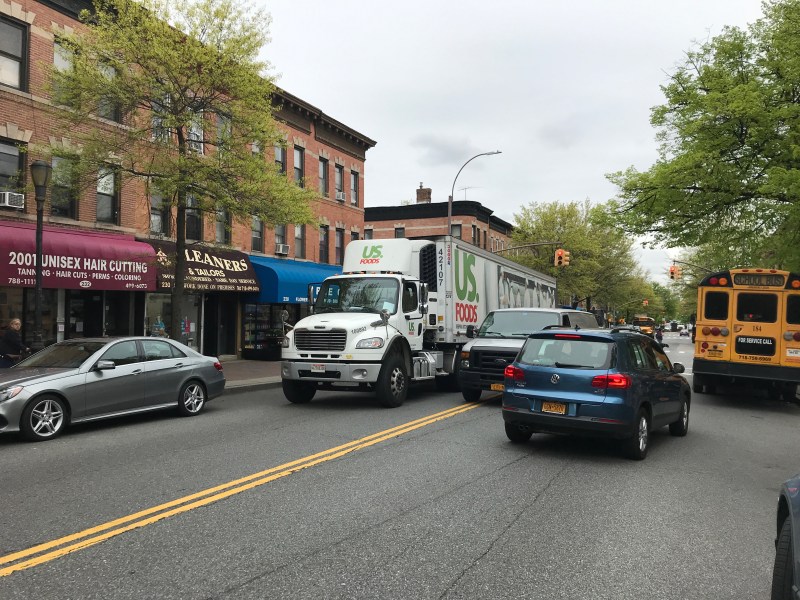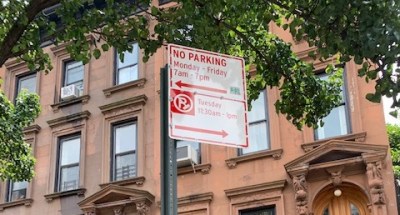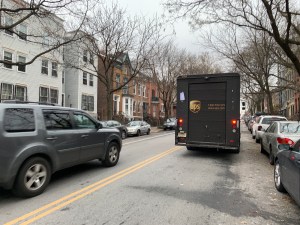The DOT Quandary: Double-Parking Isn’t Illegal — Except When It Actually Is
Believe it or not, double-parking is functionally legal for delivery companies. But trucking industry reps say a DOT proposal to tighten restrictions is unlikely to curb the practice.

Double-parking: It’s dangerous, it causes congestion — and in most parts of New York City, it’s completely legal for delivery vehicles.
DOT officials say they are doing a lot to combat the city’s delivery-induced gridlock — increasing off-hour deliveries, adding loading zones, and putting more restrictions on double-parking — but whatever they are doing has not solved an essential problem: New York City streets are a chaotic mess of delivery trucks that continue to increase in number. Twenty years into the e-commerce boom, our city’s arteries are sclerotic.
DOT has proposed a new treatment: new restrictions on double-parking that would expand a preexisting zone in Midtown where it is actively prohibited, ban it in all circumstances “when it blocks the only lane of travel in the same direction,” and, most important, enact a 20-minute limit on commercial double-parking changing enforcement language to require that drivers are “actively engaged” in making their delivery, not merely working “expeditiously” — language that has basically meant merely being nearby. [PDF]
The agency does not, however, intend to actually outlaw double-parking.
And therein lies the problem: Delivery and trucking companies — whose tickets are already heavily discounted by the city’s Stipulated Fine Program — aren’t going to stop double-parking because on many blocks, there simply is no place for them to park. For most of them — particularly global corporations like FedEx, FreshDirect, and UPS — parking tickets are simply the cost of doing business.
And whose fault is that? City government.
The scope of the problem was a central part of a DOT hearing on Wednesday about its new rules. Trucking industry representatives — long seen by street safety advocates as a villain — presented themselves instead as the maiden tied to the railroad tracks.
“We’re a captive audience, our businesses. We’ve got nowhere to go. We have to deliver the packages,” testified Ken Thorpe of the New York Trucking and Delivery Association, which represents over 700 small New York-based trucking companies. “At the end of the day, packages have to be delivered. Double-parking in necessary.”
Current city rules let drivers double-park so long as they are “expeditiously making pickups, deliveries or service calls.” Enforcement agents define “expeditious” to mean that drivers are “around.” In court, drivers who get a double-parking ticket can get it dismissed so long as they have delivery logs showing themselves present at the vehicle every half hour. So in effect, a truck can be parked for hours at one location. And if the driver gets a ticket, the fee is dramatically reduced for companies that participate in the Stipulated Fine Program.

The new 20-minute limit will change the language so that drivers are required to be “actively engaged” in making deliveries. DOT says that will mean less double-parking.
“The police department met with the Department of Finance to have a better language so the agents know that if they are not writing a ticket, there has to be someone on the vehicle actively engaged,” DOT Deputy Commissioner for Traffic Operations Josh Benson told Streetsblog on Monday. “He can’t just be checking in every 30 minutes — and that’s how the existing rules had been interpreted.”
The one place were double parking is already prohibited is a designated zone in Midtown from 14th to 60th streets between First and Eighth avenues. DOT’s proposed changes would expand that zone west to 12th Avenue.
Yet Thorpe told Streetsblog afterwards that the ultimate impact of additional penalties won’t be to reduce double-parking, but to hurt smaller businesses he represents. FedEx, FreshDirect, et al. will be fine, since they can mostly afford the tickets.
“Global companies can absorb a lot more than regular people can,” he said. “[The new rule] is not going to stop [double parking]. It can’t.”
The problem, according to industry officials (and virtually everyone else except car owners), is a lack of dedicated curbside spots for deliveries.
‘We’re only asking for the opportunity to double-park because there is not enough room to park,” testified Joel Summer, who runs a Nassau-based moving and storage company. “It is impossible for us to complete our services if only 20 minutes of double-parking is allowed.”
DOT, for its part, claims it is taking steps to expand delivery zones, such as on Austin Street in Queens.
The agency recently announced plans to expand its off-hour delivery program, which has been fairly limited so far. Only a few hundred companies currently participate. Testifying at DOT on Wednesday, Anheuser Busch Director of Operations Devin Wilzoch said only 2 percent of the company’s New York City clients have made the switch.
“What I ask is [for] the DOT’s assistance in helping us find new account bases and different customers that can help us in this journey to bring more deliveries to off-hours, reducing the amount of congestion,” Wilzoch said.
Save for that, all the city can do is clear more loading zones — which inevitably requires taking parking spots from someone else.
And the de Blasio administration doesn’t like to repurpose parking, because New York’s car-owning minority has cowed elected officials, who fear politically exhausting battles at every community board, which have proven to favor parking over safety.


